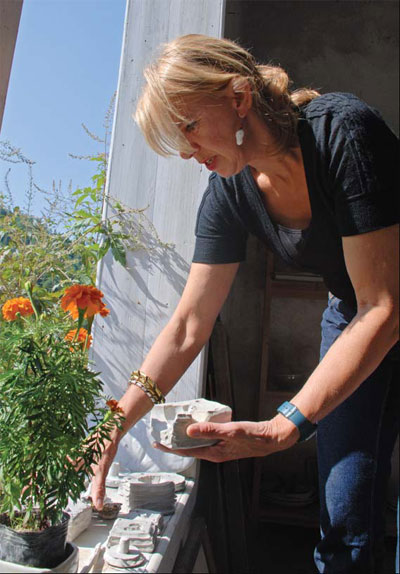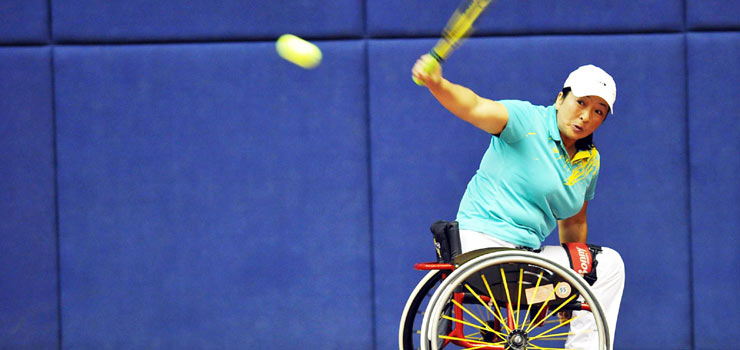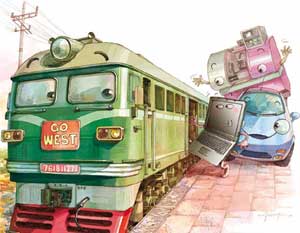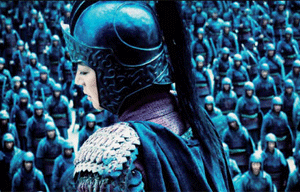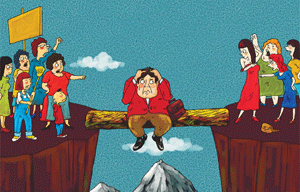Molding relationships
Updated: 2011-10-28 09:26
By Wang Chao (China Daily)
|
|||||||||
|
Pauline Wiertz, a ceramist from Delft, the Netherlands, says the Jingdezhen experience gives her inspiration for her artworks. Wang Chao / China Daily |
Porcelain helps Jingdezhen foster closer links with Western nations
There is more to this clay than meets the eye as it creates eye-catching products, and builds lasting relationships. Porcelain is the common link in Jingdezhen's close association with Delft, a city in the Netherlands, and also helped foster cross-cultural exchanges between the two cities.
Pauline Wiertz, a 56-year old ceramist from Delft, is one of the early birds to Jingdezhen under the exchange program and says that her experiences have been truly memorable.
"It was a different world to me when I landed at the tiny airport in Jingdezhen. Everything in the city was in porcelain, including the streetlight poles, the chairs and even the trash cans.
"Working here is like making a porcelain pilgrimage, as it was here that the business originated," she says.
Wiertz has been an ardent admirer of Chinese porcelain and says: "I have a whole wall of Chinese plates at home."
But the real reason for her journey is to make bonds, through combinations of clay cast from organic objects. These artworks comprise anything you can imagine - bananas, peaches, chicken feet and even insects. By deliberately assembling these casts together, she makes sets of avant-garde and whimsy clay sculptures.
"I glaze and fire the casts in the kiln to establish a coherent porcelain piece," she says.
Her recent work, Shrimp Cocktail, looks like a typical assortment of marine species at first glance. But on closer inspection, however, it turns out that severed chicken feet were used to cast the coral.
"Anything I encounter may end up in my mold," Wiertz says. "Whenever I see new stuff, I stare at the shape and ponder: Can it be incorporated into my porcelain sculpture?"
Her Jingdezhen experiences have certainly given Wiertz lots of new ideas for ceramic artworks. She shops at the local flea market and comes back with exotic articles - a broken porcelain Buddha, a traditional Chinese silver hairpin, small porcelain animals - all of which she plans to use in future works.
Wiertz also finds herself inspired by the ancient porcelain culture of Jingdezhen. "Many Chinese elements are painted on the porcelain and each of them have symbolic meanings. For example, cranes and pines mean longevity, while flowers mean blessings. I want to add these symbolic meanings into my works as well.
"In this area, I'm really a student who wants to learn from my Chinese counterparts," she says.
Wiertz says she is thinking of making a piece of the "three friends in the winter" - pines, bamboos and plums, a theme commonly seen in traditional Chinese porcelain, yet relatively unknown in Europe.
"By combining my technique and the Chinese theme, my artworks will be the real bridges between Western and Eastern cultures."
Staying at the Sanbao International Ceramic Art Studio outside downtown Jingdezhen, Wiertz also gets a chance to catch up with village life, as well as the old-fashioned ways of making ceramic art in China.
In the backyard, traditional wooden mills powered by a stream of water are pounding kaolin rocks, a raw material of clay, to powder. Wiertz and her Western friends have never seen such practices before.
"In Jingdezhen, I can see how people dig out the rock from the mountains, pound it into powder, and make it into clay materials," she says. "Back in the Netherlands when I needed to use clay, I went to the market to buy two baskets. But here I can make the raw materials by myself - it is like a musician making his own guitar! So exciting!"
As a ceramic artist active in Europe for more than 20 years, Wiertz has an electric kiln at home. But she wants to try the Chinese wood-fired kiln during her five-week stay in Jingdezhen.
"The unexpected patterns created by the flames and wood ash are just amazing," she says.
